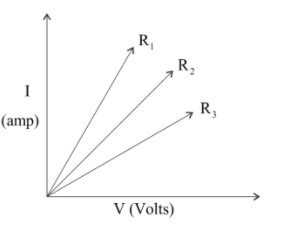
A student carries out an experiment and plots the V-I graph of three samples of nichrome wire with resistance ${R_1},{R_2},{R_3}$ respectively (see in figure). Which of the following is true?
A) ${R_1} = {R_2} = {R_3}$
B) ${R_1} = {R_2} = {R_3}$
C) ${R_1} < {R_2} < {R_3}$
D) ${R_2} > {R_3} > {R_1}$


Answer
442.6k+ views
Hint: This question can be solved by using ohm’s law and slope determining method as more the angle with the x-axis more will be the slope .As we know slope for any graph $ = \tan \theta $
Or in other words it is ratio of Y coordinate to the X coordinate
Hence, $\tan \theta = \dfrac{y}{x}$
Complete step by step answer:
According to the question given we have information from the graph as follows:
Resistance, Angle or slope for current and potential difference
As discussed above no calculative value is given so we will proceed with slope method
Always assumes of normal temperature if not given in the question because as temperature rises Ohms law will no longer be valid

According to Ohm’s Law, $V = IR$ where v is the voltage, $I$ is the current and R is the resistance
Let’s study the graph above,
Slope $ = \tan \theta = \dfrac{V}{I} = \dfrac{1}{R}$
(by ohm's law)
As $\alpha > \beta > \gamma $
So, $\tan \gamma > \tan \beta > \tan \alpha $
That means $\dfrac{1}{{{R_1}}} > \dfrac{1}{{{R_2}}} > \dfrac{1}{{{R_3}}}$
On reciprocating we get,
${R_3} > {R_2} > {R_1}$
So, the conclusion is more the angle lesser will be the resistance only for this graph
Hence option (C) is correct.
Note: Ohm's law is only valid for normal temperatures, at high temperatures it fails as wire develops lots of heat due to which resistance automatically increases and the uniformity in ohm's Law destroys. In that case resistance changes depending on the nature of material that is metal, non-metal and semiconductors.
Or in other words it is ratio of Y coordinate to the X coordinate
Hence, $\tan \theta = \dfrac{y}{x}$
Complete step by step answer:
According to the question given we have information from the graph as follows:
Resistance, Angle or slope for current and potential difference
As discussed above no calculative value is given so we will proceed with slope method
Always assumes of normal temperature if not given in the question because as temperature rises Ohms law will no longer be valid

According to Ohm’s Law, $V = IR$ where v is the voltage, $I$ is the current and R is the resistance
Let’s study the graph above,
Slope $ = \tan \theta = \dfrac{V}{I} = \dfrac{1}{R}$
(by ohm's law)
As $\alpha > \beta > \gamma $
So, $\tan \gamma > \tan \beta > \tan \alpha $
That means $\dfrac{1}{{{R_1}}} > \dfrac{1}{{{R_2}}} > \dfrac{1}{{{R_3}}}$
On reciprocating we get,
${R_3} > {R_2} > {R_1}$
So, the conclusion is more the angle lesser will be the resistance only for this graph
Hence option (C) is correct.
Note: Ohm's law is only valid for normal temperatures, at high temperatures it fails as wire develops lots of heat due to which resistance automatically increases and the uniformity in ohm's Law destroys. In that case resistance changes depending on the nature of material that is metal, non-metal and semiconductors.
Recently Updated Pages
How to find Oxidation Number - Important Concepts for JEE

How Electromagnetic Waves are Formed - Important Concepts for JEE

Electrical Resistance - Important Concepts and Tips for JEE

Average Atomic Mass - Important Concepts and Tips for JEE

Chemical Equation - Important Concepts and Tips for JEE

Concept of CP and CV of Gas - Important Concepts and Tips for JEE

Trending doubts
JEE Main Exam Marking Scheme: Detailed Breakdown of Marks and Negative Marking

JEE Main Participating Colleges 2024 - A Complete List of Top Colleges

Learn About Angle Of Deviation In Prism: JEE Main Physics 2025

Ideal and Non-Ideal Solutions Raoult's Law - JEE

A proton accelerated by a potential difference of 500 class 12 physics JEE_Main

Charging and Discharging of Capacitor

Other Pages
JEE Advanced Study Plan for 2025: Tips, Timetable, and Strategy

Collision - Important Concepts and Tips for JEE

JEE Main Chemistry Question Paper with Answer Keys and Solutions

Explain the construction and working of a GeigerMuller class 12 physics JEE_Main

If a wire of resistance R is stretched to double of class 12 physics JEE_Main

JEE Advanced Live Classes for 2025 By Vedantu




